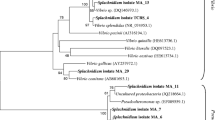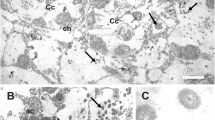Abstract
Microorganisms associated with algae and able to utilize complex substrates (e.g., plant heteropolysaccharides) may be important producers of hydrolytic enzymes. The microbial communities of the red algae Corallina sp. and Phyllophora sp. sampled in the Kandalaksha Gulf basin of the White Sea were analyzed using high-throughput sequencing of the V4-variable region of the 16S rRNA gene. The dominant phyla in microbiomes of both samples were Pseudomonadota and Bacteroidota (GTDB classification, https://gtdb.ecogenomic.org/). For the Corallina sp. sample, dominance of the Vibrio, Agarivorans, and Photobacterium genera was shown, while Granulosicoccus and Aliivibrio dominated in the Phyllophora sp. sample. The analyzed red macroalgae with associated microbiota were used as an inocula to obtain microbial enrichment cultures growing on β-1,4-xylan or β-1,3-glucan (curdlan). It was shown that, similar to environmental samples Pseudomonadota and Bacteroidota phyla representatives were prevalent in all enrichment cultures. However, unlike the environmental samples, in the enrichment cultures the dominant genera were Marinomonas, Reinekea, Polaribacter, and Pseudoalteromonas. The latter, as well as the representatives of Vibrio sp., were isolated in pure cultures for which the xylanolytic activity was shown.



Similar content being viewed by others
REFERENCES
Araki, T., Tani, S., Maeda, K., Hashikawa, S., Nakagawa, H., and Morishita, T., Purification and characterization of β-1,3-xylanase from a marine bacterium, Vibrio sp. XY-214, Biosci. Biotechnol. Biochem., 1999, vol. 63, pp. 2017‒2019.
Avcı, B., Hahnke, R.L., Chafee, M., Fischer, T., Gruber-Vodicka, H., Tegetmeyer, H.E., Harder, J., Fuchs, B.M., Amann, R.I., and Teeling, H., Genomic and physiological analyses of ‘Reinekea forsetii’ reveal a versatile opportunistic lifestyle during spring algae blooms, Environ. Microbiol., 2017, vol. 19, pp. 1209‒1221.
Avcı, B., Krüger, K., Fuchs, B.M., Teeling, H., and Amann, R.I., Polysaccharide niche partitioning of distinct Polaribacter clades during North Sea spring algal blooms, ISME J., 2020, vol. 14, pp. 1369‒1383.
Bolyen, E., Rideout, J.R., Dillon, M.R., Bokulich, N.A., Abnet, C.C., Al-Ghalith, G.A., Alexander, H., Alm, E.J., Arumugam, M., Asnicar, F., Bai, Y., Bisanz, J.E., Bittinger, K., Brejnrod, A., Brislawn, C.J., et al., Reproducible, interactive, scalable and extensible microbiome data science using QIIME 2, Nat. Biotechnol., 2019, vol. 37, pp. 852–857.
Brodie, J., Williamson, C., Barker, G.L., Walker, R.H., Briscoe, A., and Yallop, M., Characterising the microbiome of Corallina officinalis, a dominant calcified intertidal red alga, FEMS Microbiol. Ecol., 2016, vol. 92, p. fiw110.
Chikin, S.M., Tarasova, N.A., Saralov, A.I., and Bannikova, O.M., The distribution of bacterio- and mesozooplankton in the coastal waters of the White and Barents seas, Microbiology (Moscow), 2003, vol. 72, pp. 213‒220.
Deniaud, E., Quemener, B., Fleurence, J., and Lahaye, M., Structural studies of the mix-linked β-(1 → 3)/β-(1 → 4)-D-xylans from the cell wall of Palmaria palmata (Rhodophyta), Int. J. Biol. Macromol., 2003, vol. 33, pp. 9‒18.
Ducklow, H.W., Production and fate of bacteria in the oceans, Bioscience, 1983, vol. 33, pp. 494‒501.
Fisher, R.A., Corbet, A.S., and Williams, C.B., The relation between the number of species and the number of individuals in a random sample of an animal population, J. A-nim. Ecol., 1943, vol. 12, pp. 42‒58.
Gaitan-Espitia, J.D. and Schmid, M., Diversity and functioning of Antarctic seaweed microbiomes, in Antarctic Seaweeds: Diversity, Adaptation and Ecosystem Services, Gómez, I. and Huovinen, P., Eds., Cham: Springer, 2020, pp. 279‒291.
Gavrilov, S.N., Korzhenkov, A.A., Kublanov, I.V., Bargiela, R., Zamana, L.V., Popova, A.A., Peter, S.V., Golyshin, N., and Golyshina, O.V., Microbial communities of polymetallic deposits’ acidic ecosystems of continental climatic zone with high temperature contrasts, Front. Microbiol., 2019, p. 1573.
Gavrilov, S.N., Stracke, C., Jensen, K., Menzel, P., Kallnik, V., Slesarev, A., Sokolova, T., Zayulina, K., Brasen, K., Bonch-Osmolovskaya, E.A., Peng, X., Kublanov, I., and Siebers, B., Isolation and characterization of the first xylanolytic hyperthermophilic euryarchaeon Thermococcus sp. strain 2319X1 and its unusual multidomain glycosidase, Front. Microbiol., 2016, vol. 7, p. 552.
Gobet, A., Barbeyron, T., Matard-Mann, M., Mag-delenat, G., Vallenet, D., Duchaud, E., and Michel, G., Evolutionary evidence of algal polysaccharide degradation acquisition by Pseudoalteromonas carrageenovora 9T to adapt to macroalgal niches, Front. Microbiol., 2018, vol. 9, p. 2740.
Gorlenko, V.M., Puchkova, N.N., and Demchev, V.V., Photosynthesizing microorganisms of the supralittoral of the White Sea, Biol. Nauki, 1985, vol. 5, pp. 66‒72.
Gorrasi, S., Pesciaroli, C., Barghini, P., Pasqualetti, M., and Fenice, M., Structure and diversity of the bacterial community of an Arctic estuarine system (Kandalaksha Bay) subject to intense tidal currents, J. Mar. Syst., 2019a, vol. 196, pp. 77‒85.
Gorrasi, S., Pesciaroli, C., Barghini, P., Pasqualetti, M., Giovannini, V., and Massimiliano, F., Metagenetic profiling of the bacterial communities of an intertidal pool in Kandalaksha Bay (White Sea, Russia), J. Environ. Prot. Ecol., 2019b, vol. 20, pp. 1317‒1324.
Hollants, J., Leliaert, F., De Clerck, O., and Willems, A., What we can learn from sushi: a review on seaweed–bacterial associations, FEMS Microbiol. Ecol., 2013, vol. 83, pp. 1‒16.
Hsieh, Y.S.Y. and Harris, P.J., Xylans of red and green algae: what is known about their structures and how they are synthesised?, Polymers, 2019, vol. 11, p. 354.
Huggett, M.J., Williamson, J.E., De Nys, R., Kjelleberg, S., and Steinberg, P.D., Larval settlement of the common Australian sea urchin Heliocidaris erythrogramma in response to bacteria from the surface of coralline algae, Oecologia, 2006, vol. 149, pp. 604‒619.
Iriki, Y., Suzuki, T., Nisizawa, K., and Miwa, T., Xylan of siphonaceous green algae, Nature, 1960, vol. 87, pp. 82‒83.
Johnson, J., Sudheer, P.D., Yang, Y.H., Kim, Y.G., and Choi, K.Y., Hydrolytic activities of hydrolase enzymes from halophilic microorganisms, Biotechnol. Bioproc. Eng., 2017, vol. 22, pp. 450‒461.
Kim, S.J., Kim, J.G., Lee, S.H., Park, S.J., Gwak, J.H., Jung, M.Y., Chung, W.H., Yang, E.J., Park, J., Jung, J., Hahn, Y., Cho, J.C., Madsen, E.L., Rodriguez-Valera, F., Hyun, J.H., and Rhee, S.K., Genomic and metatranscriptomic analyses of carbon remineralization in an Antarctic polynya, Microbiome, 2019, vol. 7, pp. 1‒15.
Kloareg, B. and Quatrano, R.S., Structure of the cell walls of marine algae and ecophysiological functions of the matrix polysaccharides, Oceanography and Marine Biology: An Annual Review, 1988, vol. 26, pp. 259‒315.
Kravchishina, M.D., Mitzkevich, I.N., Veslopolova, E.F., Shevchenko, V.P., and Lisitzin, A.P., Relationship between the suspended particulate matter and microorganisms in the White Sea waters, Oceanology, 2008, vol. 48, pp. 837‒854.
Leliaert, F., Smith, D.R., Moreau, H., Herron, M.D., Verbruggen, H., Delwiche, C.F., and Clerck, O.D., Phylogeny and molecular evolution of the green algae, Crit. Rev. Plant Sci., 2012, vol. 31, pp. 1–46.
Mandal, A., Review on microbial xylanases and their applications, Int. J. Life Sci., 2015, vol. 4, pp. 178‒187.
Martin, M., Barbeyron, T., Martin, R., Portetelle, D., Michel, G., and Vandenbol, M., The cultivable surface microbiota of the brown alga Ascophyllum nodosum is enriched in macroalgal-polysaccharide-degrading bacteria, Front. Microbiol., 2015, vol. 6, p. 1487.
Pesciaroli, C., Rodelas, B., Juarez-Jiménez, B., Barghini, P., and Fenice, M., Bacterial community structure of a coastal area in Kandalaksha Bay, White Sea, Russia: possible relation to tidal hydrodynamics, Ann. Microbiol., 2015, vol. 65, pp. 443‒453.
Pielou, E.C., The measurement of diversity in different types of biological collections, J. Theor. Biol., 1966, vol. 13, pp. 131‒144.
Qeshmi, F.I., Homaei, A., Fernandes, P., Hemmati, R., Dijkstra, B.W., and Khajeh, K., Xylanases from marine microorganisms: a brief overview on scope, sources, features and potential applications, Biochim. Biophys. Acta—Proteins Proteom., 2020, vol. 1868, p. 140312.
Ray, S., Vigouroux, J., Bouder, A., Allami, M.F., Geairon, A., Fanuel, M., Ropartz, D., Helbert, W., Lahaye, M., and Bonnin, E., Functional exploration of Pseudoalteromonas atlantica as a source of hemicellulose-active enzymes: evidence for a GH8 xylanase with unusual mode of action, Enzyme Microb. Technol., 2019, vol. 127, pp. 6‒16.
Romankevich, E.A. and Vetrov, A.A., Tsikl ugleroda v arkticheskikh moryakh Rossii (Carbon Cycle in Arctic Seas of Russia), Moscow: Nauka, 2001.
Savvichev, A.S., Rusanov, I.I., Yusupov, S.K., Bairamov, I.T., Pimenov, N.V., Lein, A.Y., and Ivanov, M.V., The process of microbial sulfate reduction in sediments of the coastal zone and littoral of the Kandalaksha Bay of the White Sea, Microbiology (Moscow), 2003, vol. 72, pp. 478–489.
Savvichev, A.S., Rusanov, I.I., Zakharova, E.E., Veslopolova, E.F., Mitskevich, I.N., Kravchishina, M.D., Lein, A.Yu., and Ivanov, M.V., Microbial processes of the carbon and sulfur cycles in the White Sea, Microbiology (Moscow), 2008, vol. 77, pp. 734‒750.
Semenova, E.V., Shlykova, D.S., Semenov, A.M., Ivanov, M.N., Shelyakov, O.V., and Netrusov, A.I., Bacterial epiphytes of brown algae involved in oil utilization in the ecosystems of Northern seas, Moscow Univ. Biol. Sci. Bull., 2009, no. 3, pp. 18‒22.
Shannon, C.E. and Weaver, W., The Mathematical Theory of Communication, Urbana: University of Illinois, 1949, vol. 117.
Shuvaeva, G.P. and Sysoeva, M.G., Xylanase of the micromycete Rhizopus var. microsporus 595: preparation, structural and functional characteristics, and application, Appl. Biochem. Microbiol., 2010, vol. 46, pp. 641‒647.
Singh, R.P. and Reddy, C.R.K., Seaweed–microbial interactions: key functions of seaweed-associated bacteria, FEMS Microbiol. Ecol., 2014, vol. 88, pp. 213‒230.
Sorensen, T.A., A method of establishing groups of equal amplitude in plant sociology based on similarity of species content and its application to analyses of the vegetation on Danish commons, Biol. Skar., 1948, vol. 5, pp. 1‒34.
Suleiman, M., Krüger, A., and Antranikian, G., Biomass-degrading glycoside hydrolases of archaeal origin, Biotechnol. Biofuels, 2020, vol. 13, pp. 1‒14.
Trias, R., García-Lledó, A., Sánchez, N., López-Jurado, J.L., Hallin, S., and Bañeras, L., Abundance and composition of epiphytic bacterial and archaeal ammonia oxidizers of marine red and brown macroalgae, Appl. Environ. Microbiol., 2012, vol. 78, pp. 318‒325.
Umemoto, Y., Shibata, T., and Araki, T., D-xylose isomerase from a marine bacterium, Vibrio sp. strain XY-214, and D-xylulose production from β-1,3-xylan, Mar. Biotechnol., 2012, vol. 14, pp. 10‒20.
Vortsepneva, E., Chevaldonné, P., Klyukina, A., Naduvaeva, E., Todt, C., Zhadan, A., Tzetlin, A., and Kublanov, I., Microbial associations of shallow-water Mediterranean marine cave Solenogastres (Mollusca), PeerJ, 2021, vol. 9, p. e12655.
Xing, P., Hahnke, R.L., Unfried, F., Markert, S., Huang, S., Barbeyron, T., Harder, J., Becher, D., Schweder, T., Glöckner, F.O., Amann, R.I., and Teeling, H., Niches of two polysaccharide-degrading Polaribacter isolates from the North Sea during a spring diatom bloom, ISME J., 2015, vol. 9, pp. 1410‒1422.
Yoon, H.S., Nelson, W., Lindtrom, S.C., Boo, S.M., Pueschel, C., Qiu, H., and Bhattacharya, D., Rhodophyta, in Handbook of the Protists, Archibald, J.M., Simpson, A.G.B., and Slamovits, C.H., Eds., Cham: Springer, 2017a, pp. 89–133.
Yoon, K., Song, J.Y., Kwak, M.J., Kwon, S.K., and Kim, J.F., Genome characteristics of the proteorhodopsin-containing marine flavobacterium Polaribacter dokdonensis DSW-5, J. Microbiol., 2017b, vol. 55, pp. 561‒567.
Yu, W.N., Du, Z.Z., Chang, Y.Q., Mu, D.S., and Du, Z.J., Marinomonas agarivorans sp. nov., an agar-degrading marine bacterium isolated from red algae, Int. J. Syst. Evol. Microbiol., 2020, vol. 70, pp. 100‒104.
Zavarzin, G.A., The rise of the biosphere, Microbiology (Moscow), 1997, vol. 66, pp. 603‒611.
ACKNOWLEDGMENTS
The authors are grateful to E.N. Vinogradova (Moscow State University) for assistance in identification of algae and in preparation of pure culture samples for sequencing, to A.Yu. Merkel (Research Center of Biotechnology) for assistance in statistical analysis of the data, and to A.B. Tzetlin, director of the Pertsov Biological Station, as well as to all the personnel of the station, for the provided possibility to use the research facilities of the station.
Funding
The study was supported by the Ministry of Science and Higher Education of the Russian Federation (agreement no. 075-15-2021-1396).
Author information
Authors and Affiliations
Corresponding author
Ethics declarations
Conflict of interest. The authors declare that they have no conflict of interests.
Statement on the welfare of animals. This article does not contain any studies involving animals or human participants performed by any of the authors.
Additional information
Translated by D. Timchenko
Rights and permissions
About this article
Cite this article
Salova, V.D., Kholdina, A.M., Melnik, A.D. et al. Microbial Communities Associated with the White Sea Red Algae as a Source of Xylanolytic Microorganisms. Microbiology 92, 418–426 (2023). https://doi.org/10.1134/S002626172360026X
Received:
Revised:
Accepted:
Published:
Issue Date:
DOI: https://doi.org/10.1134/S002626172360026X




